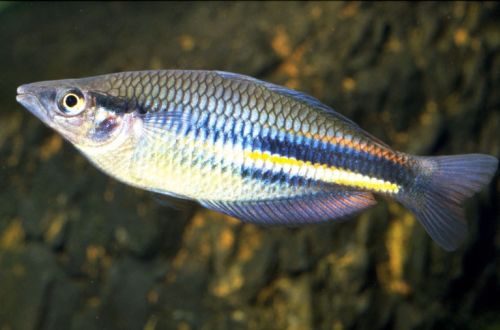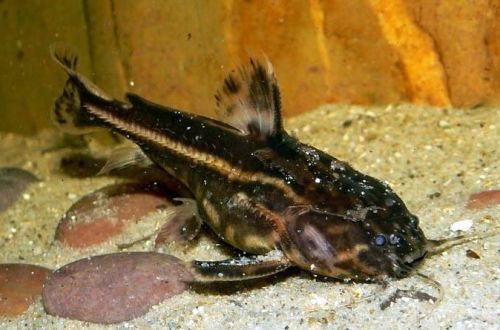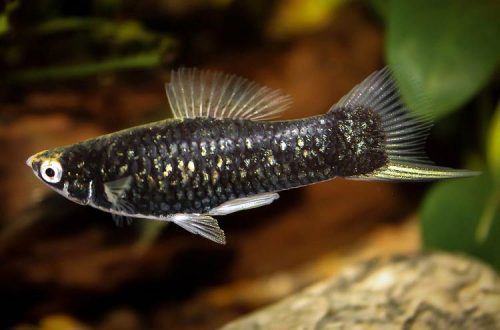
New Guinea rainbow
The New Guinea Rainbow or Melanothenia northern, scientific name Melanotaenia affinis, belongs to the Melanotaeniidae family. Beautiful, peaceful and unpretentious fish, perfectly adapted to life in a variety of conditions, so they will not cause much trouble when kept in a home aquarium.

Contents
Habitat
It comes from Papua New Guinea. It occurs in various biotopes, from tropical swamps to coastal waters. Prefers regions with dense aquatic vegetation and areas with flooded shrubs and fallen trees. The natural habitat is subject to seasonal changes (water hydrochemistry, temperature).
Brief information:
- The volume of the aquarium – from 110 liters.
- Temperature – 20-30°C
- Value pH — 6.5–8.0
- Water hardness – medium and high hardness (10-20 dGH)
- Substrate type – any
- Lighting – subdued / moderate
- Brackish water – no
- Water movement – weak/absent
- The size of the fish is up to 12 cm.
- Food – any food
- Temperament – peaceful active
- Keeping a flock of at least 6-8 individuals
Description
Under the same name, they usually sell three very similar varieties of the same species. Adults reach a length of up to 12 cm. The color is iridescent, with a predominance of yellow and bluish hues with a green tint (depending on the region of origin). A horizontal ribbon of dark, yellow, orange stripes runs along the body. The tail and fins have a complex coloration that combines almost all the colors of the rainbow. Sexual differences are weakly expressed, males are only slightly larger and more colorful than females, which is hardly noticeable in a large flock.
Food
Undemanding to the diet and nutritional composition. Accepts most popular foods (dry, frozen, live). It is advisable to combine different products, for example, flakes and granules to serve together with bloodworms. Such a diet will allow the fish to maintain bright colors in their coloration.
Maintenance and care, decoration of the aquarium
The optimal size of the aquarium for a flock of 6-8 adult fish starts from 110 liters. The design uses a lot of floating and rooting plants. Vegetation is arranged in patches to preserve open spaces for swimming. The remaining elements of the decor are not so important and are selected at the discretion of the aquarist.
Maintaining high water quality is essential. A productive filtration system and regular replacement of part of the water with fresh water will ensure acceptable conditions for keeping the New Guinean Rainbowfish.
It is worth remembering that this species does not tolerate strong movement of water, and the filter is the main cause of internal flow in the aquarium. Therefore, the choice of model and its installation should be taken carefully.
Behavior and Compatibility
Peaceful active fish, compatible with other species of comparable size and temperament. However, they can cause inconvenience to slower neighbors in the aquarium. The content is flocking, at least 6–8 individuals of both sexes. No intraspecific conflicts were noted.
Breeding / breeding
Raduzhnitsy breeding is possible both in general and in a separate spawning aquarium. Favorable conditions for the beginning of the mating season are achieved at a temperature of 24–26°C, in water of medium hardness with pH values close to neutral. The design should contain thickets of small-leaved plants or their artificial analogues, among which eggs will be laid. And, as mentioned above, the internal flow should be minimized.
Spawning lasts about 2 weeks, during this time the female will lay several dozen eggs daily, and the male will fertilize them. Parental instincts are not developed, therefore, after the end of spawning, the fish do not show any interest in future offspring. If breeding was carried out in a common aquarium, then it is advisable to move the eggs to a separate tank with identical conditions. Otherwise, there is a great risk of them being eaten by other fish.
The incubation period lasts about 7-12 days. In the first days of life, fry are able to eat only microscopic food, for example, ciliates. After a week, you can serve brine shrimp nauplii or specialized powdered food for juveniles.
Fish diseases
Health problems arise only in case of injuries or when kept in unsuitable conditions, which depresses the immune system and, as a result, provokes the occurrence of any disease. In the event of the appearance of the first symptoms, first of all, it is necessary to check the water for the excess of certain indicators or the presence of dangerous concentrations of toxic substances (nitrites, nitrates, ammonium, etc.). If deviations are found, bring all values back to normal and only then proceed with treatment. Read more about symptoms and treatments in the Aquarium Fish Diseases section.





